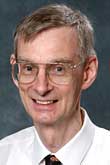
Biography
Peter Barry is an Emeritus Professor in the School of Medical Sciences and Department of Physiology from 2003. He had also been a Conjoint Professor from 2002-2015. Prior to that he had been a Professor of Physiology from 1994-2001, before he retired in 2002. His research is in membrane biophysics. He originally graduated from the University of Sydney (Australia) with a BSc (Hons) in Physics in 1963, followed by a PhD in Biophysics in 1968. ...view more
Peter Barry is an Emeritus Professor in the School of Medical Sciences and Department of Physiology from 2003. He had also been a Conjoint Professor from 2002-2015. Prior to that he had been a Professor of Physiology from 1994-2001, before he retired in 2002. His research is in membrane biophysics. He originally graduated from the University of Sydney (Australia) with a BSc (Hons) in Physics in 1963, followed by a PhD in Biophysics in 1968. He then did 3 years (1967-1970) of post-doctoral work with Dr Jared Diamond in Physiology at the University of California at Los Angeles (UCLA), just over a year at the Physiological Laboratory in the University of Cambridge (1970-1971), working with Dr Richard Adrian before coming to UNSW, initially for 2 years as a Q E II Fellow (1972 &1973) collaborating with Dr Peter Gage, and taking up a lectureship in the School of Physiology and Pharmacology in 1974.
Research Interests:
His interests and those of his research groups have included exploring the mechanisms of ion permeation and selectivity in ion channels, the relationship between the molecular structure and the physiological function of channels, such as those of the inhibitory neurotransmitter receptor glycine channel and the olfactory cyclic nucleotide-gated channel, and investigating the factors that determine their ion permeation, selectivity and conductance. For many years, it also included the role of unstirred-layers on biological phenomena. Many of these studies highlighted the significant effects of liquid junction potentials on membrane potential measurement, which are generally increased in patch-clamp situations. This resulted in analyses to evaluate and correct errors arising from such liquid junction potentials in a range of different situations and led him to develop a C/C++ DOS-based Windows software program, JPCalc, to calculate and apply appropriate corrections to experimental membrane potential measurements. The program was subsequently reprogrammed into full Windows versions; see Interactive Electrophysiology Software. His current research is now concentrating on liquid junction potential effects on membrane potential measurements and their role in ion permeation and selectivity, and the reliability of their calculation and measurement, including the importance of using ion activities in their calculation in many situations, and complications that can arise in solutions containing polyvalent ion mixtures.
Broad Research Areas:
Membrane Biophysics, Electrophysiology, Physiology, Neuroscience
Qualifications:
BSc (Hons), PhD (Syd), DSc (NSW)
Society Memberships & Professional Activities:
President, Australian Society for Biophysics, 2003-2004; Member, National Committee for Biomedical Sciences of the Australian Academy of Science, 2003-2005;, Emeritus member of The Biophysical Society (U.S.A.); Honorary Life member of The Australian Physiological and Pharmacological Society. Currently also Emeritus member of the New York Academy of Sciences (U.S.A.); Emeritus member of The Society of General Physiologists (U.S.A); The Australian Society for Biophysics; Association: Fellow of the Institute for the Study of Christianity in an Age of Science and Technology (ISCAST).
Specific Research Keywords:
Liquid Junction Potentials, Ion Channels, Structure & Function of Ion Channels, Ligand gated ion channels, Unstirred Layer Effects
Location
Department of Physiology,
School of Medical Sciences,
Rm G01, Level G NW, Wallace Wurth Bldg